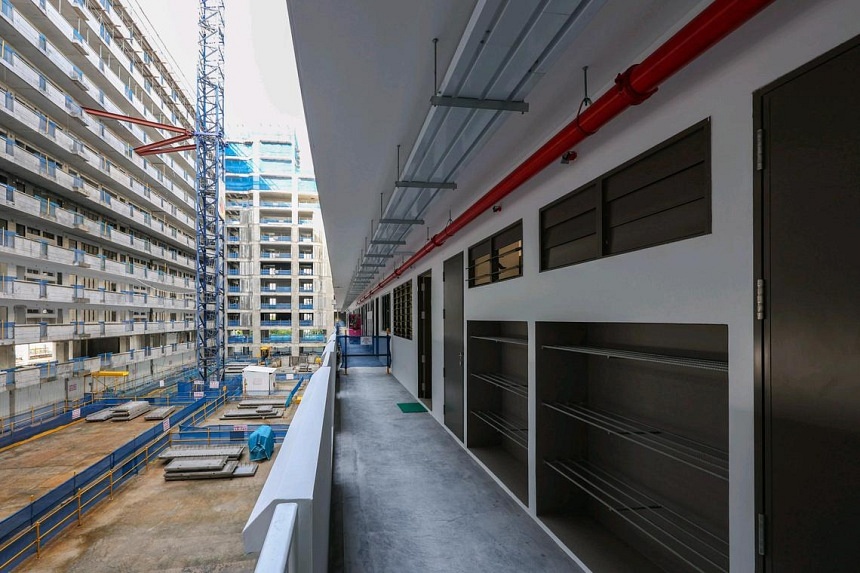https://www.straitstimes.com/singapore/mom-unveils-new-designs-for-migrant-worker-dormitories
MOM to open new dorm in early 2026 with privacy nooks, single beds for migrant workers

SINGAPORE - A new foreign worker dormitory in Jurong – the first to be built and owned by the Government – will offer more personal space and privacy to its residents when it opens in early 2026.
With a fresh room layout, privacy nooks on each floor, and a dedicated space in each room for socialising and small-group prayers, the 2,400-worker dormitory in Tukang Innovation Lane will showcase new ways of designing living quarters for migrant workers, MOM said in a progress update on Nov 17.
The dormitory is the first of two that will be built and owned by the Ministry of Manpower (MOM), with the other government-owned dorm in Sengkang West expected to be completed around mid-2028.
Speaking to the media on Nov 17 after a visit to the Tukang dormitory site, Manpower Minister Tan See Leng said MOM hopes to spur other dorm operators to continue to improve, and potentially speed up their transition to better standards.
“We can demonstrate to them what are some of the improvements that are not just necessary, but also commercially viable.”
The two MOM dormitories are among seven upcoming dormitories being built to a set of higher standards, which about 1,000 of the 1,500 existing dorms are required to meet only by 2040.
Under the more stringent requirements, which were introduced in 2021 after the Covid-19 pandemic, there will be a cap of 12 residents per room at MOM’s Tukang dorm. This is unlike the majority of today’s dorms, where up to 16 workers, sometimes more, typically share a room.
Each resident at the new Tukang dorm will get at least 4.2 sq m of living space, up from 3.5 sq m of living space in most dorms now.
Residents of the new MOM dorm will also have access to en-suite toilets and in-room Wi-Fi, amenities that migrant workers here largely do not enjoy yet.
Dormitories built before September 2021 have been given a transition period to meet the higher standards, to ensure minimal disruption to the dormitory bed supply, which has been tight.
Still, some progress has been made, with newer dorms built after September 2021 having to abide by the stricter requirements.
All this is part of ongoing efforts by MOM to raise the quality of foreign worker accommodation in Singapore, after the Covid-19 pandemic laid bare the conditions of worker dormitories here.

A key innovation at the MOM Tukang dorm is the type of beds that will be used and how they will be configured.
MOM said extensive consultations on the design of its Tukang dorm had been conducted with workers, non-governmental organisations, industry associations, and an advisory panel comprising experts in architecture, healthcare infrastructure and other subjects.
After hundreds of design iterations, a mock-up of the new dorm room was displayed at a migrant worker recreation centre in April to gather more feedback.
In each of the 210 rooms at the Tukang dorm, six of the 12 beds will be single-deckers.
The remaining six beds will have a loft bed design, with lower bed frames that are independent of the one above, so as to minimise disturbance to those sleeping on the lower bunk.
This new configuration does not meet MOM’s requirement for there to be at least 1m of space between beds, MOM said at a briefing.
However, the ministry roped in the Agency for Science, Technology and Research to conduct an airflow and droplet transmission study and found that with sufficient partitions and better ventilation, the new room layout fulfilled workers’ desire for more privacy while meeting the public health standards for newer dorms.

Sleep disturbance due to bunk beds used in existing dorms was one of the bugbears raised by the workers MOM had consulted.
Mr Sumun Biswas, a 44-year-old hydraulic operator who was among the migrant workers consulted about the new dorm, recounted how he had to sleep on triple-decker beds at some of his previous dorms.
The Bangladeshi, who has been working in Singapore for 16 years, was pleased to see single beds at the Tukang facility.
“We are happy to see this new dormitory. We want every dormitory in Singapore to be like this,” he told The Straits Times.
Outside their rooms, MOM said, residents of the new Tukang dorm will be able to make use of multiple green spaces within the dorm’s premises to play sports or relax.
MOM said it has worked with the National Parks Board on landscaping improvements, which are aimed at creating a home-like atmosphere for workers.
For instance, plants and trees that are familiar to migrant workers will be grown within the dormitory premises. They include champak and neem trees, which are native to South-east Asia and the Indian sub-continent.
In creating a more conducive living environment, the design of the new Tukang dormitory also allows for more efficient use of space.
For example, communal kitchens, which will be located on each floor of the new dorm, have been designed to reduce overcrowding, and communal dining areas can be repurposed as social and recreational spaces, MOM said.

The new dormitory has also been designed with future public health threats in mind, with colour-coded access routes making it easier for workers to find their way around, and to physically segregate them should the need arise, MOM added.
In addition, there will be multiple entry and exit points to prevent congregation, and automated thermal scanners at gantries to identify residents with high temperatures.
Other technological solutions in the pipeline include a digital access control system that will streamline the check-in process for dorm residents.
These solutions will be implemented by NESST Singapore, a company limited by guarantee set up by MOM to run the new Tukang dorm with private sector partners.
The corporate entity will allow the ministry to be directly involved in dorm operations, so it can test new innovations and grow its own dorm management capabilities.
The idea is for best practices to be shared with the wider dormitory industry so that some of the innovations at Tukang will be adopted more widely, said MOM.

Dr Tan, speaking to the media on Nov 17, said: “We don’t intend to go into this space to compete with them, but to really set what we think should be the benchmarks.”
Meanwhile, a deeper understanding of how dorms here operate will also enable MOM to develop better policies and regulations, the ministry said previously.
While beds at the new dorm will come at a higher price than those offered at older dorms, MOM did not say how much each bed will cost.
MOM said NESST will adopt a “calibrated pricing strategy” to ensure bed prices are competitive and in line with industry norms.
“NESST has engaged in extensive consultations with employer groups to ensure that bed pricing aligns with the expectations of both employers and workers,” MOM added, pointing to the need to ensure the new dorm is commercially viable.
The ministry also said response has been positive so far, with employers like construction firm Bachy Soletanche already expressing interest in securing some of the rooms.


Comments
Post a Comment